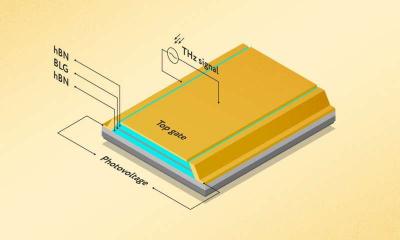A team of researchers from Russia, UK, Japan and Italy has created a graphene-based terahertz detector.

The team explains that the reason for the inefficiency of existing terahertz detectors is the mismatch between the size of the detecting element, the transistorâabout one-millionth of a meterâand the typical wavelength of terahertz radiation, which is about 100 times greater. This results in the wave passing the detector by without any interaction.
Implementing such a detector proved harder than anticipated. In most semiconductor materials, plasmons undergo rapid dampingâthat is, they die downâdue to electron collisions with impurities. Graphene was seen as a promising way out, but until recently, it was not clean enough.
The authors of the research presented a solution for the long-standing problem of resonant T-wave detection. They created a photodetector made of bilayer graphene encapsulated between crystals of boron nitride and coupled to a terahertz antenna. In this sandwich structure, impurities are expelled to the exterior of the graphene flake, enabling plasmons to propagate freely. The graphene sheet confined by metal leads forms a plasmon resonator, and the bilayer structure of graphene enables wave velocity tuning in a wide range.
The team has developed a compact terahertz spectrometer, several microns in size, with the resonant frequency controlled via voltage tuning. The researchers have also shown the potential of their detector for fundamental research: by measuring the current in the detector at various frequencies and electron densities, plasmon properties can be revealed.
"Our device doubles up as a sensitive detector and a spectrometer operating in the terahertz range, and it's also a tool for studying plasmons in two-dimensional materials. All of these things existed before, but they took up a whole optical table. We packed the same functionality into a dozen micrometers," said co-author Dmitry Svintsov, who heads the Laboratory of 2-D Materials for Optoelectronics at the Moscow Institute of Physics.



